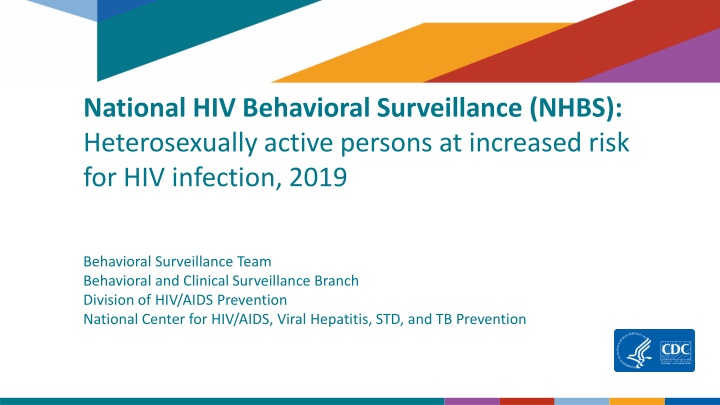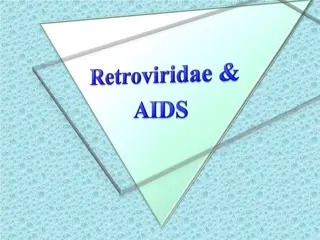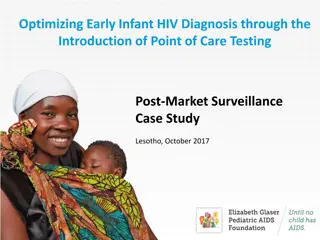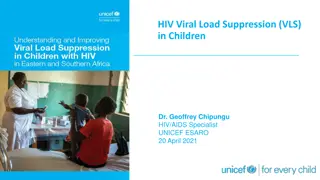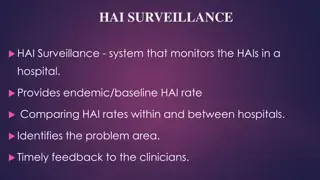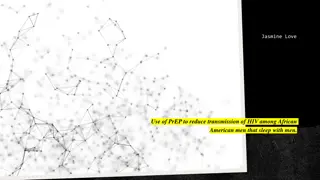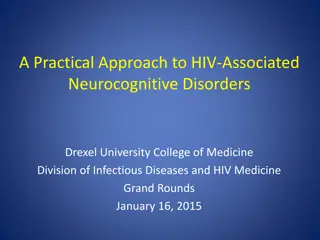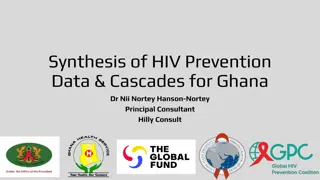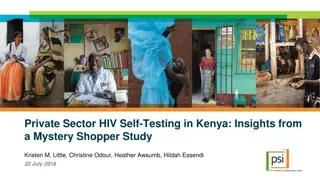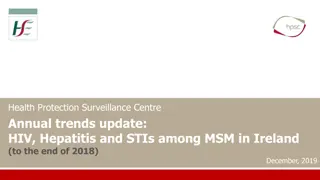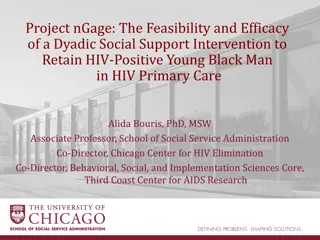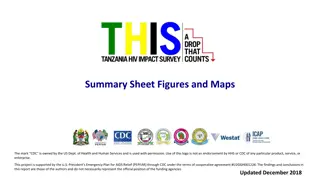National HIV Behavioral Surveillance (NHBS): Insights and Findings
NHBS is a comprehensive system initiated in 2003 by the CDC to monitor HIV prevalence, associated behaviors, testing rates, and prevention service usage among populations at high risk. The program surveys three key populations in rotating cycles and covers various project areas across the U.S. to provide critical data for resource allocation and program development. By monitoring trends and local concerns, NHBS plays a crucial role in addressing HIV prevention and control efforts.
Download Presentation

Please find below an Image/Link to download the presentation.
The content on the website is provided AS IS for your information and personal use only. It may not be sold, licensed, or shared on other websites without obtaining consent from the author.If you encounter any issues during the download, it is possible that the publisher has removed the file from their server.
You are allowed to download the files provided on this website for personal or commercial use, subject to the condition that they are used lawfully. All files are the property of their respective owners.
The content on the website is provided AS IS for your information and personal use only. It may not be sold, licensed, or shared on other websites without obtaining consent from the author.
E N D
Presentation Transcript
National HIV Behavioral Surveillance (NHBS): Heterosexually active persons at increased risk for HIV infection, 2019 Behavioral Surveillance Team Behavioral and Clinical Surveillance Branch Division of HIV/AIDS Prevention National Center for HIV/AIDS, Viral Hepatitis, STD, and TB Prevention
Outline Background, Objectives, Populations, Participants Slides 3-7 Methods Slides 8-10 Demographics Slides 11-18 Sexual Behaviors Slides 19-23 HIV Testing & Prevention Slides 24-31 Resources and Acknowledgments Slides 32-33
NHBS: Background Started in 2003 CDC s comprehensive system for conducting bio-behavioral surveillance among persons at increased risk for HIV infection State/local health departments with a metropolitan statistical area/division with high prevalence of HIV are eligible to participate in NHBS NHBS provides data to steer resources and programs https://www.cdc.gov/hiv/statistics/systems/nhbs/index.html
NHBS: Objectives Monitor prevalence and trends in: HIV infection HIV associated behaviors HIV testing Use of prevention services Monitor topics of local importance in each project area
NHBS: Populations NHBS surveys three populations in rotating annual cycles: Men who have sex with men (MSM) Persons who inject drugs (PWID) Heterosexually active persons at increased risk of HIV infection (HET) MSM 2011 HET 2013 PWID 2012 MSM 2003-04 MSM 2008 PWID 2009 HET 2010 HET 2006-07 PWID 2005 MSM 2014 HET 2016 MSM 2017 HET 2019 PWID 2015 PWID 2018 Three annual cycles are considered a round
23* NHBS Project Areas in Round 5 (2017-2019) Seattle Portland Boston Nassau New York City Newark Philadelphia Baltimore Detroit Chicago San Francisco Denver Washington, DC Virginia Beach/Norfolk Los Angeles Memphis San Diego Atlanta Dallas Houston New Orleans Miami San Juan *Baltimore was not funded under the Funding Opportunity Announcement that covered 2016 HET and Round 5 but is participating in Round 5. https://www.cdc.gov/hiv/statistics/systems/nhbs/projectareas.html
NHBS: Participants and Data NHBS data are anonymous Participants complete a standardized questionnaire with a trained interviewer All participants are offered an HIV test For each cycle, general NHBS eligibility criteria are: Age of 18 years Residence in participating city No previous participation during the current survey cycle Ability to complete the survey in either English or Spanish Ability to provide informed consent
NHBS 2019 HET Cycle Additional eligibility Identify as male or female Had opposite sex partner in the past 12 months Age 60 years Sample goals 500 participants per city (low income) Income not exceeding 150% of HHS poverty guidelines, adjusted for geographic differences in cost of living Not PWID or MSM
HIV Infection, Risk, Prevention, and Testing Behaviors Among Heterosexually Active Adults at Increased Risk for HIV Infection, 2019 https://www.cdc.gov/hiv/pdf/library/reports/surveillance/cdc-hiv-surveillance-special-report-number-26.pdf
Methods: Respondent-Driven Sampling Initial recruits ( seeds ): Know the population of interest Live in census tracts with high poverty rates May recruit up to 5 people they know Eligible recruits: Complete survey May recruit up to 5 people they know Recruitment process continues until: Sample size is met or Sampling period ends https://www.cdc.gov/hiv/pdf/statistics/systems/nhbs/NHBS_Model_Protocol_Round5.pdf
NHBS Recruitment and Analysis Sample, 2019 Recruited (n = 15,263) Did not meet eligibility criteria (n = 2,731) Eligible to participate (n = 12, 532 ) Excluded due to lost data (n = 248) Completed interviews with valid data (n = 12,284 ) Excluded due to history of injection drug use, male-male sex, or not classified as low income (n = 2,702) Heterosexually active participants at increased risk for HIV infection (n = 9,582 ) https://www.cdc.gov/hiv/pdf/library/reports/surveillance/cdc-hiv-surveillance-special-report-number-26.pdf
Heterosexually Active Participants by Gender, NHBS, 2019 Males Females 45% 55%
HIV Status* of Heterosexually Active Participants by Gender, NHBS, 2019 HIV-Negative HIV-Positive 98.5% 98.2% 1.8% 1.5% Males Females *Participants with a valid NHBS HIV test result. Participants who were HIV-positive had a reactive rapid NHBS HIV test result supported by a second rapid test or supplemental laboratory-based testing.
Heterosexually Active Participants by Age Group, NHBS, 2019 50-60 23% 40-49 19% 30-39 24% 25-29 14% 18-24 19% Numbers might not sum to 100% due to rounding
Heterosexually Active Participants by Race/Ethnicity, NHBS, 2019 68% 22% 4% 4% 1% Black/African American Hispanic/Latino White Multiple Races Other Hispanic/Latino can be of any race; Other includes Asian, American Indian/Alaska Native, and Native Hawaiian/Other Pacific Islander Numbers might not sum to 100% due to rounding
Heterosexually Active Participants by Education Level, NHBS, 2019 College degree or more 3% Some College or technical degree 22% High school or equivalent 50% Less than high school 26% Numbers might not sum to 100% due to rounding
Heterosexually Active Participants who Visited a Health Care Provider, past 12 months, NHBS, 2019 Heterosexually Active Participants by Current Health Insurance Status, NHBS, 2019 80% 76% 24% 20% Visited Not Visited Insured Not Insured
Heterosexually Active Participants by Homelessness Status, past 12 month, NHBS, 2019 Heterosexually Active Participants by Federal Poverty Level, NHBS, 2019 81% 74% 26% 19% Below Above Homeless Not Homeless
Sexual Behaviors with Female Sex Partners among Heterosexually Active Men, NHBS, 2019 100% 84% 27% 20% Vaginal Sex Condomless Vaginal Sex Anal Sex Condomless Anal Sex
Sexual Behaviors with Female Sex Partners among Heterosexually Active Men by Partner Type, NHBS, 2019 80% Main Partner Casual Partner 68% 63% 42% Vaginal or Anal Sex Condomless Vaginal or Anal Sex
Sexual Behaviors with Male Partners among Heterosexually Active Women, NHBS, 2019 100% 89% 28% 24% Vaginal Sex Condomless Vaginal Sex Anal Sex Condomless Anal Sex
Sexual Behaviors with Male Partners among Heterosexually Active Women by Partner Type, NHBS, 2019 Main Partner Casual Partner 84% 75% 53% 39% Vaginal or Anal Sex Condomless Vaginal or Anal Sex
Heterosexually Active Participants Ever Testing for HIV by Gender, NHBS, 2019 82% 76% Males Females
Heterosexually Active Participants Testing for HIV in the past 12 months by Gender, NHBS, 2019 41% 38% Males Females
Setting of Most Recent HIV Test among Heterosexually Active Men and Women who were tested for HIV in the past 12 months, NHBS, 2019 Clinical Setting Nonclinical Setting 82% 73% 19% 13% Males Females Clinical settings include private doctor s office (including HMO), emergency department, hospital (inpatient), public health clinic or community health center, family planning or obstetrics clinic, correctional facility, or drug treatment program. Nonclinical settings include HIV counseling and testing site, HIV street outreach program or mobile unit, syringe services program, or home.
Setting of Most Recent HIV Test among Heterosexually Active Men and Women who were tested for HIV in the past 12 months by Age Groups, NHBS, 2019 Clinical Setting Non-Clinical Setting 84% 83% 78% 75% 73% 22% 19% 15% 11% 11% 18-24 25-29 30-39 40-49 50-60 18-24 25-29 30-39 40-49 50-60 Clinical settings include private doctor s office (including HMO), emergency department, hospital (inpatient), public health clinic or community health center, family planning or obstetrics clinic, correctional facility, or drug treatment program. Nonclinical settings include HIV counseling and testing site, HIV street outreach program or mobile unit, syringe services program, or home.
PrEP Awareness and Use by Gender among Heterosexually Active HIV-Negative Men and Women, NHBS, 2019 PrEP Awareness PrEP Use 35% 29% 0.5% 0.4% Males Females
PrEP Awareness and Use by Race/Ethnicity among Heterosexually Active HIV-Negative Men and Women, NHBS, 2019 PrEP Awareness PrEP Use 47% 41% 40% 36% 33% 30% 18% 1.7% 0.8% 0.5% 0.5% 0.2% 0.0% 0.0% American Indian/Alaska Native Asian Black/African American Hispanic/Latino Native White Multiple Races Hawaiian/Other Pacific Islander Hispanic/Latino can be of any race
Receipt of HIV care and Treatment among Self- Reported HIV-positive Heterosexually Active Men and Women, NHBS, 2019 Ever Within 1 month of Diagnosis During past 6 months 93% 89% 83% 80% 59% 51% Males Females
NHBS Resources Surveillance Report https://www.cdc.gov/hiv/pdf/library/reports/surveillance/cdc-hiv- surveillance-special-report-number-26.pdf NHBS Publications: https://www.cdc.gov/hiv/statistics/systems/nhbs/publications.html NHBS Project Areas: https://www.cdc.gov/hiv/statistics/systems/nhbs/projectareas.html
Acknowledgements This slide set was prepared by the following CDC staff: Terence Hickey, Dafna Kanny, Amy Baugher, Susan Cha, Johanna Chapin-Bardales, Jason (Jincong) Freeman, Elana Morris, Cyprian Wejnert, Teresa Finlayson. NHBS study participants, project area staff, contractors. NHBS Study Group: Atlanta, GA: Pascale Wortley, Jeffery Todd, David Melton; Baltimore, MD: Colin Flynn, Danielle German; Boston, MA: Monina Klevens, Shauna Onofrey, Conall O Cleirigh; Chicago, IL: Antonio D. Jimenez, Irina Tabidze, David Kern; Dallas, TX: Margaret Vaaler, Jie Deng; Denver, CO: Alia Al-Tayyib, Daniel Shodell; Detroit, MI: Emily Higgins, Vivian Griffin, Corrine Sanger; Houston, TX: Salma Khuwaja, Zaida Lopez, Paige Padgett; Los Angeles, CA: Ekow Kwa Sey, Yingbo Ma, Hugo Santacruz; Memphis, TN: Monica Kent, Jack Marr, Meredith Brantley; Miami, FL: Emma Spencer, David Forrest, Monica Faraldo; Nassau-Suffolk, NY: Bridget J. Anderson, Ashley Tate, Meaghan Abrego; New Orleans, LA: William T. Robinson, Narquis Barak, Jacob Chavez; New York, NY: Sarah Braunstein, Alexis Rivera, Sidney Carrillo; Newark, NJ: Abdel R. Ibrahim, Afework Wogayehu, Corey Rosmarin-DeStafano; Philadelphia, PA: Kathleen A. Brady, Jennifer Shinefeld, Tanner Nassau; Portland, OR: Timothy W. Menza, E. Roberto Orellana, Lauren Lipira; San Diego, CA: Sheryl Williams, Anna Flynn, Adam Bente; San Francisco, CA: Willi McFarland, Desmond Miller, Danielle Veloso; San Juan, PR: Sandra Miranda De Le n, Yadira Rol n-Col n, Mar a Pab n Mart nez; Seattle, WA: Tom Jaenicke, Sara Glick, Jennifer Reuer; Virginia Beach, VA: Jennifer Kienzle, Brandie Smith, Toyah Reid; Washington, DC: Jenevieve Opoku, Irene Kuo. This research was supported in part by an appointment to the Research Participation Program at the Centers for Disease Control and Prevention administered by the Oak Ridge Institute for Science and Education through an interagency agreement between the U.S. Department of Energy and CDC.
NHBS General Inquiries: NHBS@cdc.gov For more information, contact CDC 1-800-CDC-INFO (232-4636) TTY: 1-888-232-6348 www.cdc.gov The findings and conclusions in this report are those of the authors and do not necessarily represent the official position of the Centers for Disease Control and Prevention.
